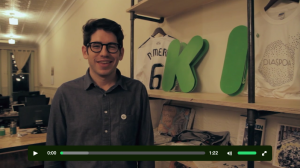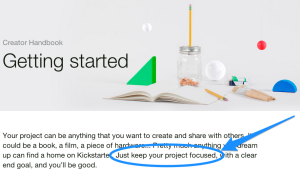
Quick, what does the NRA (a national gun rights advocate) have in common with crowdfunding giant Kickstarter?
Well, not much it turns out.
But because I’m from Montana, I’m going to use a firearms metaphor to discuss Kickstarter’s new Creator Handbook which they released last week.
You would think that if anyone out there can hit the bullseye with crowdfunding advice, it ought to be the largest crowdfunding platform out there, right?
Well, sorta…
For music crowdfunders, it turns out the Creator Handbook is really more like a shotgun than a rifle.
Instead of nailing things dead center every time, it sends out a spray of buckshot that hits close to the mark but isn’t always right on target.
Especially for musicians.
Here are 6 things I like and don’t like about Kicktarter’s new Creator Handbook that will help you appropriately apply their advice so you make the most money and save the most time.
Dislike: Kickstarter’s Over-Exaggerated “Community”
Kickstarter is more than just a funding tool. It’s a community of millions of people who love to share and support creative things. ~ Kickstarter’s Hello page.
Sorta, but don’t get too carried away here…
For most successful music projects, Kickstarter will claim to give you about 5-20% of your traffic and funds.
But the truth is that about half of that number is just people that you’ve driven to Kickstarter who use the search functionality to find your traffic.
So, the number is closer to 2.5-10% of your project, which is great and about covers Kickstarter’s fees, but it’s not exactly a windfall and you won’t be able to surf their wave to success!
Like: Kickstarter Suggests You Stay Focussed
Getting Started is a gentle kickoff to the extremely large volume of work that you’ll be doing.
But there’s a subtle pearl of wisdom in the first paragraph: Just keep your project focused, with a clear end goal, and you’ll be good.
You’d be surprised at how difficult that is.
Over the course of project creation, you’ll oscillate between complete certainty that your campaign will be a run-away success and the crippling fear of “what if nobody pledges”.
A common byproduct of this process is that campaign creators start trying to get fancy and they end up outthinking themselves in the meantime.
For example, many creators will try to tie a semi-related (or, even worse, a completely unrelated) non-profit cause in with their project.
Or sometimes a project that is clearly for a recording project will try to drum up extra interest by tacking on some big live event or music video or even a book.
The problem is that if you aren’t a crystal-clear communicator, these do more to muddle up your project than to add value.
It is generally best to stick to the facts and communicate first WHY you are doing your project (Purpose and Mission) and second WHAT your project is (an EP, an LP, a tour, etc.).
[Picture examples of muddled up projects?]
Like & Dislike: Kickstarter’s Video Example
Let’s start with the good.
The two main points of Kickstarter’s example video on the Your Story page are pretty darn accurate.
Kickstarter Video Tip #1: Be Personable and Authentic.
 Don’t sabotage yourself by over-hyping yourself as if you’re talking to a huge audience whose willingness to back your project is directly proportionate to the number of gratuitous adjectives you use to describe your music.
Don’t sabotage yourself by over-hyping yourself as if you’re talking to a huge audience whose willingness to back your project is directly proportionate to the number of gratuitous adjectives you use to describe your music.
Awesome, amazing, best-ever… Even if those are true (and they probably are), they aren’t authentic words because they don’t tell the viewer about your project in any relatable manner.
When you film your video whether it’s with an iPhone or your production team, imagine that you are talking to your closest friend. Use the the language you’d speak while talking to them.
This trick will leave the inauthenticity behind and will help you sound like a normal person whose project is accessible and can be personally connected to by the viewer.
Kickstarter Video Tip #2: Just Make It!
People stress out, over-plan, scheme and spend way too much timeand money worrying about this part of their campaign.
Yancy has some pretty good words of advice about that:
There’s no wrong way to do it, you just have to make one… You can make a project video with just about anything… Just sit in front of a camera, press record and let it go. ~ Yancy Strickler
Honestly, before you watch any more Kickstarter videos, search for How-Tos or spend another second worrying about your video…
JUST GET OUT YOUR PHONE!
And spend two minutes recording yourself talking about your project as if you are talking to your best friend.
This single step, more than any other you’ll take, will propel you towards getting your video finished.
WARNING: Don’t Take Yancy’s Words Literally
Don’t mistake Yancy’s words to mean that you can say just about anything and you’ll be good to go.
Welcome to my Kickstarter page, help me make a new record. Heeeee-hawww. ~anonymous “musician” in Kickstarter offices
And certainly don’t listen to that guy!
The first thing you need to talk about in your video is WHY you do what you do in the first place.
This is not why you are doing your project. It’s on a deeper, more existential level.
We call this Purpose and Mission.
You need to communicate this to each and every backer. It should be meaningful and almost philosophical.
Something where the viewer tilts their head as they are listening and thinks “yeah, man, right on, I believe in that, too.”
Spend more time talking about this in your video than anything else. (Minimum of 60 seconds if not 90.)
Dislike: Kickstarter’s Advice on How To Price Rewards
Kickstarter gives a few examples of rewards in this section of the Creator Handbook.
These examples are fine though not exhaustive or particularly helpful.
But their advice on pricing rewards is misleading.
Small rewards are where it’s at!
You obviously need to have small rewards which we classify as costing $50 or less.
 And though these rewards will likely account for 70% of your total backers, according to my research, they will most often account for only 25%-35% of your total funding.
And though these rewards will likely account for 70% of your total backers, according to my research, they will most often account for only 25%-35% of your total funding.
For musicians, mid-level and upper-level rewards deserve the most attention because that’s where you get most of your funding!
Be certain to price your Acoustic House Concert, Album Credits, Song of the Month and/or Personalized Songs or Video greetings correctly.
If you price them too low, you leave a bunch of money on the table when people donate less than they would have.
If you price them too high, you leave a bunch of money on the table when nobody pledges.
For example, you are a singer/songwriter who regularly plays solo gigs in the area for $400-600 per night.
That’s about where you’ll want to price the Acoustic House Concert reward.
Not $200 and not $1000!
LIKE: Kickstarter Knows Who Will Back Your Project
After talking about their “community” at the beginning of their Creator Handbook, Kickstarter almost seems to contradict themselves in the Funding section by saying:
…most of your support will come from your core networks and the folks who are most familiar with you and your work—family, friends, etc.
YAAAAAY!
I am glad to see some sanity and reason prevail here!
So many musicians are under the false impression that there are a ton of strangers out there who will pledge to the campaign if they just see it.
This is almost never the case.
Instead, your backers (like 90-95% of them) will come from your existing circles of fans, friends and family.
So as you’re figuring out your goal amount, don’t worry about “getting in front of more people” or “reaching new markets”.
Instead, spend your time listing out your already existing market which is, again, your fans, friends and family.
Kickstarter also points this out on their Promotion page.
An exceptional project can lead to outpourings of support from all corners of the web. But for most projects, support will come from the people you know.
As a musician, your #1 job is to communicate with those people.
You should especially do this before you worry about pitching the press which is by and large a complete waste of time for 99.99% of all music projects.
You might get covered, but you won’t get backers from the coverage… So save your effort for later on in your marketing cycle and spend your time during your campaign talking to the people you know.
INTERESTING SIDE NOTE ON FUNDING
Beyond deductions, a creator may be able to classify certain funds raised on Kickstarter as a nontaxable gift, and not income. A gift is something given out of “detached and disinterested generosity” for personal reasons and without the expectation of getting something in return. ~ https://www.kickstarter.com/help/taxes
Some people give without selecting a reward. Turns out, that’s not taxable income near as I can tell by reading Kickstarter’s help page!
Dislike: Kickstarter’s Recommended Reading
Kickstarter developed their list of Further Reading to apply to all of their crowdfunding genres including tech, design, games, fashion, etc.
But even the link they give for running a music project really isn’t for music. It’s too general.
The article isn’t completely wrong but it is just not specific enough.
Read around the Launch and Release blog including our 100 Music Kickstarters To Learn From.
Read my guest post at the DIY Musician Blog by CD Baby.
And if you want to save yourself days, weeks and months of hassle, check out the 6 Blueprints which make up the Music Crowdfunding System. (And note that there’s a FREE COURSE you can sign up for!!)

As a lifelong jazz saxophonist, presenter, promoter and President of a non-profit membership Jazz Society, I find much of the previous information to be potentially very supportive for my kickstarter project target.